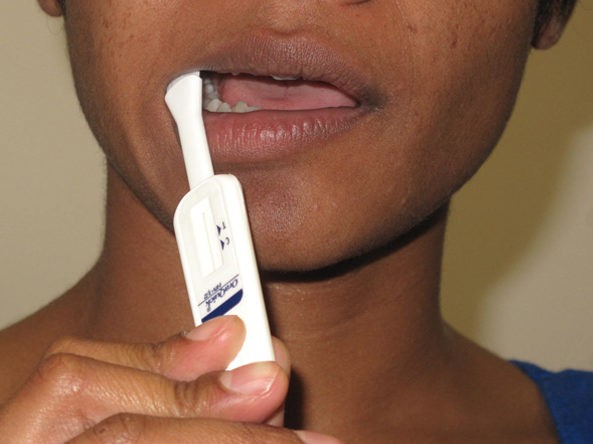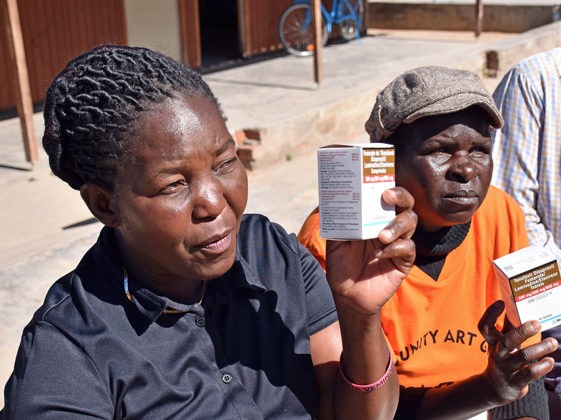Article and Study Summary:
Treating Depression and Improving Adherence in HIV Care with Task-Shared Cognitive Behavioural Therapy in Khayelitsha, South Africa: A Randomized Controlled Trial
Published in:
Journal of the International AIDS Society 2021, 24:e25823.
https://onlinelibrary.wiley.com/doi/10.1002/jia2.25823
Authors:
Safren SA, O’Cleirigh C, Andersen LS, et al.
Summary:
This was a two-arm randomized controlled effectiveness trial that aimed to test task-shared cognitive-behavioral therapy for adherence and depression (CBT-AD) in people living with HIV (PLHIV), delivered by clinic nurses in a public clinic that provides HIV services in Khayelitsha, a peri-urban community outside of Cape Town, South Africa. Study participants were PLHIV with a current diagnosis of depression and not virally suppressed from first-line ART. They were randomized (1:1) into enhanced treatment as usual or CBT-AD delivered by a trained nurse interventionist, hired by the study team. The nurse had a mental health background and received training in psychotherapy and clinical supervision as part of the study. To facilitate task sharing, the study adapted the Life-Steps manual to a flipbook translated into the local language. The CBT-AD treatment included eight required sessions and nine optional monthly booster sessions. An electronic Wisepill device was used as a measurement tool for adherence and provided the nurse with prior week adherence information that was used during the CBT-AD sessions to discuss adherence. Primary outcomes included adherence assessed between baseline and the 4-month assessment via Wisepill, and depression assessed by a clinician via the Hamilton Depression Scale at the 4-month assessment. Secondary outcomes included measures of depression, adherence and viral load over 12 months of follow up. The task-shared, nurse-delivered, CBT-AD intervention was found to be effective in increasing adherence and viral suppression and decreasing depression over 12 months among PLHIV with clinical depression and unsuppressed viral load.
Discussion Questions:
- How could the findings in this study impact policy where you work?
- What would it take to implement the CBT-AD in the programs you work with? Do you have any experiences to share?
Please share your thoughts and experiences with us in the comments section below.
Full Synopsis:
PDF version available in English, French, and Portuguese.
Study Summary
This was a two-arm randomized controlled effectiveness trial that aimed to test task-shared cognitive-behavioral therapy for adherence and depression (CBT-AD) in people living with HIV (PLHIV), delivered by clinic nurses in South Africa.
Study Setting
- The study took place at a public clinic that provides HIV services in Khayelitsha, a peri-urban community outside of Cape Town. Although psychological services are not available at this clinic, the medical officer can prescribe antidepressants and refer to a larger provincial clinic or a non-governmental organization.
- The current study builds on the authors’ formative work, where they pilot tested the intervention with nurse interventionists in a small open trial and had promising results on feasibility, acceptability, and effectiveness outcomes.
Methods
- This was a two-arm randomized controlled effectiveness trial over a 12-month period, comparing 1) enhanced treatment as usual (ETAU arm); and 2) ETAU combined with task-shared CBT-AD delivered by a trained nurse interventionist hired by the study team (CBT-AD arm).
- Inclusion criteria: PLHIV with a current diagnosis of depression and not virally suppressed from first-line ART per local clinic standard (viral load >400 copies/ml).
- Exclusion criteria: PLHIV unable or unwilling to provide informed consent, active untreated major mental illness (e.g., untreated psychotic or mania) that would interfere with treatment, received CBT for depression, or age <18 years old.
- Research assistants screened potential participants using the major depressive disorder (MDD) module of the Mini International Neuropsychiatric Interview (MINI). Those who met criteria for MDD and did not have a viral load test in the past month underwent phlebotomy.
- Participants in both arms received ETAU, including feedback to the participant and their HIV care provider concerning the participant’s diagnosis of depression. Usual care for those who had not achieved viral suppression included medications for one month and meeting with an adherence counsellor individually, a return visit and repeat prescription with adherence counselling at one month, and again three months later with a blood draw for viral load. If viral load was still >1000 copies/ml, patients were referred to a risk of treatment failure group which entailed additional adherence support such as one to three counselling sessions that may or may not follow a structured format (similar to Life-Steps).
- The CBT-AD intervention was delivered by nurses with a mental health background who received training in psychotherapy and clinical supervision as part of the study. The CBT-AD treatment was delivered using a flipbook based on the Life-Steps manual and included eight sessions organized across several modules based on individual participant’s needs:
-
- Life-Steps adherence counselling, adapted to the local setting (~one session)
- Introduction to CBT, psychoeducation about the nature of depression, and motivational interviewing for behavior change (~one session)
- Behavioral activation through increasing value-driven pleasurable activities and mood monitoring (~two sessions)
- Problem-solving, particularly for problems related to HIV self-care (~two sessions)
- Relaxation training (~one session)
- Review and relapse prevention (~one session)
-
- An electronic Wisepill device, which transmits a real-time signal to a web server when the pillbox is opened, was used as a measurement tool for adherence in both study arms. In the CBT-AD arm, nurses used prior week adherence information during the CBT-AD sessions to discuss any adherence issues with the participant.
- Participants in the CBT-AD arm received travel reimbursement and had the option to participate in up to nine monthly booster sessions following treatment completion that included a brief review of content. Approximately 68% of participants attended one booster session, 51% attended two boosters, 39% attended three boosters and 35% attended four or more booster sessions.
- Participants in both study arms received compensation for time spent in the assessment visits. Primary outcomes included: 1) adherence assessed between baseline and the 4-month assessment via Wisepill; and 2) depression assessed by a clinician via the Hamilton Depression Scale (HAM-D) at the 4-month assessment.
- Secondary outcomes included: depression assessed by self-report using the Center for Epidemiologic Studies Depression Scale (CES-D) at baseline and follow-up; HAM-D clinician-assessed depression over follow-up; adherence over follow-up; percentage of participants with undetectable viral load at 12 months; and CD4 cell counts at 12 months.
- Study assessments (HAM-D, CES-D) were administered by a clinical assessor, who was blinded to study arm.
Study Population and Follow-up
- Between July 2016 and June 2019, 161 eligible participants were randomized: 80 participants to CBT-AD and 81 participants to ETAU. 70% of participants were female; 72% completed more than eight grades of school; 51% were re-initiated on first-line ART and 49% were on second-line ART; and 4% of CBT-AD participants and 9% of ETAU participants were prescribed antidepressant medication at randomization.
- Of 80 CBT-AD participants, 86% attended all eight sessions of the intervention.
Primary Outcome
- Adherence between baseline and 4 months. There was a significant time by study arm interaction during the acute treatment phase such that each week between randomization and four months, participants in the CBT-AD study arm improved their adherence by approximately 1.61 percentage points more than ETAU per week (95% confidence interval [CI]: 0.64, 2.58; p=0.001). During this time, those receiving ETAU decreased adherence by approximately 1.48 percentage points per week (CI: -21.2, -0.84), while the CBT-AD study arm showed a nonsignificant weekly increase in adherence by approximately 0.13 percentage points (CI: -0.60, 0.86). The sensitivity test censoring for potential Wisepill non-usage revealed a similar pattern of results, showing superiority of the CBT-AD intervention.
- Depression between baseline and 4 months (HAM-D). There was a significant interaction of time by study arm in HAM-D scores from baseline to four months indicating that those in the CBT-AD arm improved by an estimated 4.88 points (CI: -7.86, -1.87; p = 0.0016) more than those in ETAU.
Secondary Outcomes
- Depression between baseline and 4 months (CES-D). Superiority of CBT-AD on acute treatment of depression was replicated with the self-report CES-D scores, indicating that participants in the CBT-AD arm improved by an estimated 9.08 points (CI: -14.03, -4.12; p = 0.0004) more than those in the ETAU arm during this time.
- HAM-D depression over follow-up. CBT-AD maintained superiority for lower depression over time on the HAM-D. Over the 4-, 8- and 12-month follow-ups, participants in the CBT-AD arm had an estimated 5.63 points lower scores (CI: –7.90, –3.36; p < 0.001) over time than those in the ETAU arm.
- Adherence over follow-up. CBT-AD maintained superiority over the 4-, 8- and 12-month timepoints, with approximately 24 percentage points higher adherence than ETAU (est = 23.56, CI: 13.25, 33.88; p < 0.001).
- Undetectable viral load at 12 months. At 12 months, 32% of individuals in the CBT-AD arm had an undetectable viral load compared to 20% in the ETAU arm (adjusted odds ratio [OR] 2.51, CI: 1.01, 6.66; p = 0.047). Those in CBT-AD had a 3.54 greater odds of having an undetectable viral load over the three follow-up timepoints (CI: 1.59, 20.50; p = 0.038).
Critical Analysis
In this randomized controlled trial in Khayelitsha, South Africa, a task-shared, nurse-delivered, CBT-AD intervention with Wisepill was found to be effective in increasing adherence and decreasing depression over 12 months among PLHIV with clinical depression and unsuppressed viral load. The present study demonstrates the effectiveness of a task-shared treatment of both depression (via CBT) and adherence (via WisePill) in individuals with clinical depression and uncontrolled HIV. Further evidence that CBT-AD is feasible and acceptable is that 86% of patients assigned to CBT-AD attended all eight sessions.
The following points should be considered when interpreting the study findings:
- Although Wisepill measures when the pillbox is opened and closed, it does not measure whether the person actually ingested the medicine. This limitation is mitigated, however, by the viral load results and sensitivity analysis.
- Implementing this intervention in a real-world setting as conducted in the trial (tracking retention, reminder calls, Wisepill, etc.), as well as using clinic-based staff and supervisors rather than study interventionists and supervisors, may require significant resources. The authors are currently conducting a cost-effectiveness analysis, which will be important for policy implications.
- Although there were improvements in viral load in those in the CBT-AD arm compared to those in the ETAU arm, only approximately one-third were virally suppressed at 12 months. The study did not have stored samples to examine whether the marked improvements in adherence via Wisepill that did not result in viral suppression were due to resistance to the ART regimen.
- The effect of booster sessions could not be examined because they were optional. Therefore, the use of booster sessions may be related to participants’ need for them, which would create bias.
Implications
This study found that task-shared, nurse-delivered CBT-AD is effective in improving clinical depression, ART adherence, and viral load in PLHIV with unsuppressed viral load. A combination intervention that addresses behavioral (adherence), psychological (depression), and biomedical (viral load) outcomes is highly relevant given the prevalence of clinical depression and its association with adherence among PLHIV. This study demonstrates that in low- and middle-income countries where there is shortage of mental health professionals, it is possible to train nurses in delivering CBT-AD. This task-shared approach may be scaled up to populations of individuals with other chronic conditions. However, the study intervention is resource-intense, which may make the intervention prohibitive in many settings. Further investments may be needed in order to implement it in public health settings.
This article synopsis was written by Dr. Yael Hirsch-Moverman. Share your thoughts on this article or suggest an article for Journal Club by emailing her at yh154@columbia.edu.
References
- Joska, John A et al. Nurse-Delivered Cognitive Behavioral Therapy for Adherence and Depression Among People Living With HIV (the Ziphamandla Study): Protocol for a Randomized Controlled Trial. JMIR research protocols vol. 9,2 e14200. 3 Feb. 2020, doi:10.2196/14200. Available at: https://www.ncbi.nlm.nih.gov/pmc/articles/PMC7055790/
Articles of Note:
- The Likelihood of Severe COVID-19 Outcomes Among PLHIV with Various Comorbidities: A Comparative Frequentist and Bayesian Meta-analysis Approach
- Associations Between HIV Infection and Clinical Spectrum of COVID-19: A Population Level Analysis Based on US National COVID Cohort Collaborative (N3C) Data









